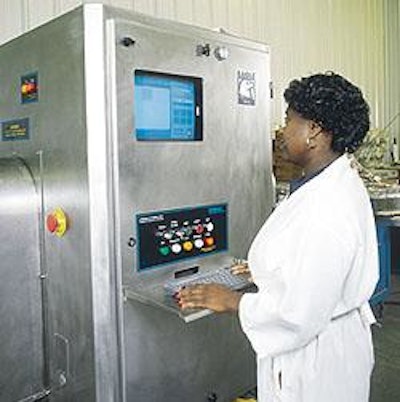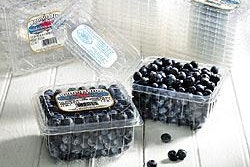Flavor Delite, Inc. of Richburg, SC, uses X-ray vision on-line to peer inside packaged products. All of the company?s retail products packed in spiral-wound canisters are checked by an Eagle Tall? X-ray inspection system from Smiths Heimann(Alcoa, TN). Started up in July ?01, the X-ray system is located on the production line following the seaming of canisters, but before they are packed off into cases.
It checks for ?anything? out of the ordinary, according to Jeff Wylie, vice president of sales, who headed the equipment search. ?With this system, there?s a much greater control of quality assurance, product consistency, and confidence that the best product possible is being offered to the consumer.?
Privately held Flavor Delite manufactures and distributes Jane?s Krazy Mixed-Up Salt, Jane?s Krazy Mixed-Up Pepper, Jane?s Krazy Lemon Pepper, Jane?s Lime Pepper Marinade, David?s Kosher Salt, Cerulean Seas Sea Salt, and Twin Tree Garden Spices. The products are sold to supermarkets and retailers domestically and worldwide.
Many of the items are packed in foil-lined spiral-wound paper canisters ranging in sizes from 2.5 to 14 oz. Supplied by Hayes Manufacturing Group, Container Division (Greenville, WI), the bottom-filled canisters have a plastic shaker top and a metal base that?s seamed on.
Best of both worlds
The company sought a contaminant detection system that could be located as close as possible to the end of the packaging line. Metal detectors were tested and deemed ineffective because of the canister?s foil lining, which is essential to maintain the freshness of the spices, and the seamed-on metal end. The company even considered eliminating the metal in its containers by converting to an all-plastic can. But, acknowledges Wylie, ?test results didn?t turn out as well as we?d hoped.?
Foiled by attempts to use metal detection, Flavor Delite was led to Smiths Heimann, whose X-ray system ?fit our needs perfectly,? Wylie says.
With the X-ray system, the company gets a whole lot more performance than a metal detector could deliver. ?This finally worked out to be the best of both worlds,? says Wylie. ?We could keep the [spiral wound] canister, which is a proven container, and we can ?see? through it to check for anything inside such as clumps. It handles quality assurance as well as looks for foreign matter.?
The system uses low-power X-rays to peer inside the packaged product. The gray-scale X-ray image is analyzed by Smiths Heimann?s Simul-Task? software as it looks for differences in density compared to a preset standard. It can detect foreign objects such as stones, glass, product clumps, and metal pieces. The density data also yields information on product weight by detecting underfilled canisters. Any canister that deviates from the programmed parameters is rejected automatically by a pneumatic arm that knocks the canister from the conveyor. It is part of the system and is located a foot beyond the machine exit.
Filled, seamed, and inspected
The line operates daily. After mixing of ingredients, the seasoning is dispensed into the canisters volumetrically by a four-station auger filler. Then the canister?s metal base is seamed on and ink-jet coded prior to the container undergoing X-ray inspection.
Products are conveyed on a 7??-wide plastic belt through the X-ray system?s tunnel or aperture, which accepts packages up to 12?? tall. The company?s canister heights range from about 3?? to 10?? high. The Eagle Tall was developed specifically to handle upright containers. Wylie says another X-ray system they considered would have forced the company to lay the packages on their sides for scanning.
The system is rated at 300?/min, although Flavor Delite runs it at rates of 42 to 62 canisters/min depending on the product. The machine front houses a computerized operator interface. ?Instant off? switches are located on two sides of the machine. Wylie says that the X-ray machine, which lengthened the line by about 10?, fits perfectly into the production line.
Once the machine is set for the product on the line, it does not have to be adjusted in any way until the product is changed. Flavor Delite provided Smiths Heimann with 10 samples of various products that it used to program the machine. ?That?s the advantage of the Heimann machine?all of the items are preset in the computer?s memory,? Wylie notes. He says that would have been their biggest challenge if they had not had the assistance of the Heimann technical support staff: ?Their technicians were extremely thorough, precise, and explained to us, in layman?s terms, everything we needed to know. They made sure that we were able to operate the machine with confidence.
?If a piece of metal, for example, is in a canister, the machine reads the difference in density as an abnormality and rejects the package,? explains Wylie. After four months of production, the system has rejected four canisters, he reports. Subsequent checks found that the canisters contained ?abnormally large? pieces of black peppercorn, he says.
Savings and growth
Some tasks now done by the X-ray system had been previously accomplished through visual inspection, so the company also realized labor savings. Rather than have to visually inspect packages at the filler and seamer, they have been able to shift the operators? duties elsewhere, Wylie says. He says that ?actual data on return-on-investment is still being analyzed. This [system] eliminates the possibility of liability claims, confirms the weight of each canister, and ensures that the product sold to the consumer is in perfect condition.?
Because of growth in overseas markets, Wylie predicts company sales will double.
?The machine has performed exceptionally well,? says Wylie. ?We could not ask for a better device. It is simple to use, and the employees were easily trained to operate it within the safety guidelines associated with an X-ray machine. It is like a ?guardian angel? overlooking the whole packaging process.?
Wylie feels that the Heimann X-ray system ?provides the best quality assurance available today. If the product successfully passes through the Heimann X-ray machine, you can be assured that you are distributing the finest product possible.?


























